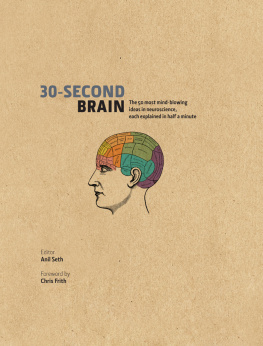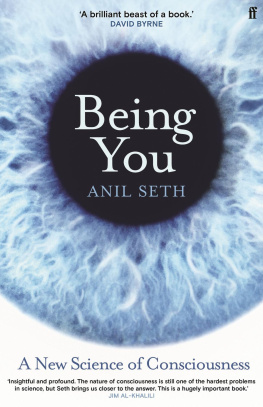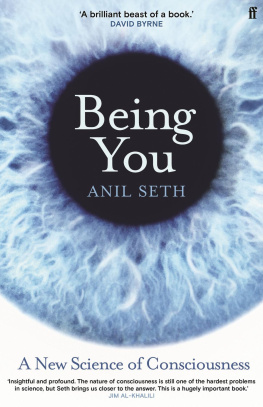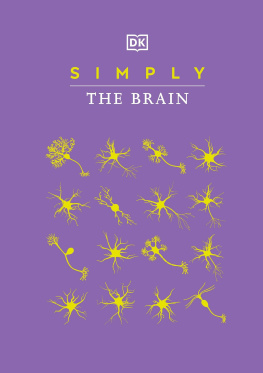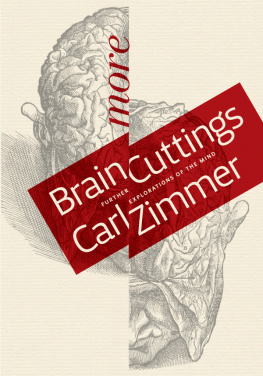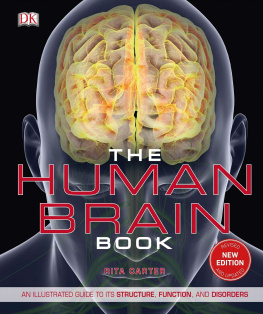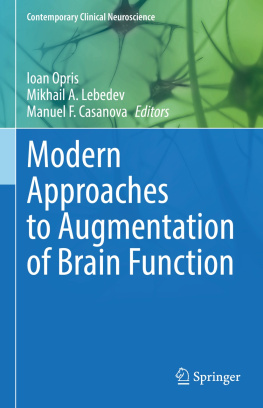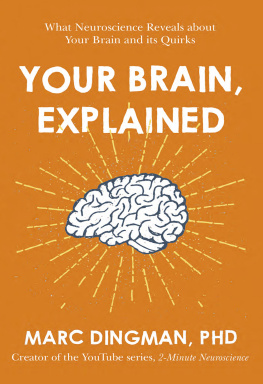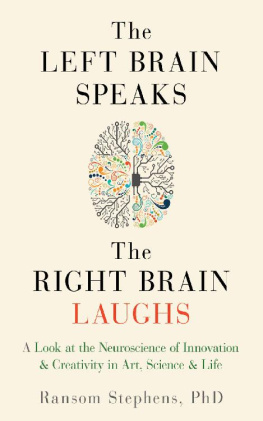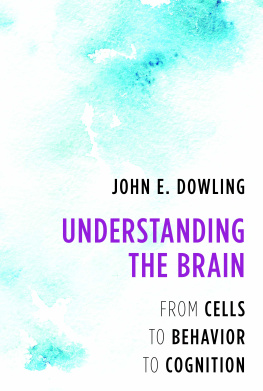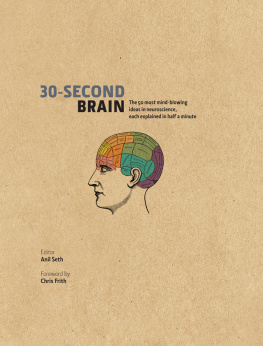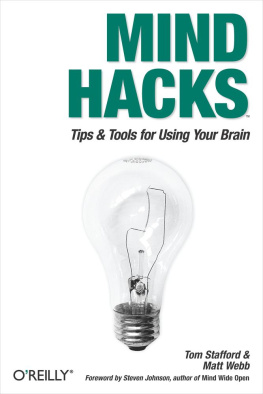
30-SECOND
BRAIN
The 50 most mind-blowing ideas in neuroscience, each explained in half a minute
Editor
Anil Seth
Foreword by
Chris Frith
Contributors
Tristan Bekinschtein
Daniel Bor
Christian Jarrett
Ryota Kanai
Michael OShea
Anil Seth
Jamie Ward

Are we all at the mercy of our brain chemistry?
Do you think that the amygdala and the hippocampus are fantastical sea monsters?
What can an MRI scan tell us?
Could you explain to dinner-party guests why we dont giggle when we tickle ourselves?
30 Second Brain is the quickest way to understand whats happening inside your head, challenging experts in the field to explain the 50 most mind-blowing theories in neuroscience. Each entry is summarized in just 30 seconds using nothing more than two pages, 300 words and a single picture. Discover how the networks of 90 billion nerve cells work together to produce perception, action, cognition and emotion. Explore how your brain defines your personality, and what it gets up to while you are asleep. Illustrated with mind-bending graphics and supported by biographies of pioneers in the field of neuroscience, its the book to get your grey matter thinking about your grey matter.
First published in the UK in 2012 by Icon Books Ltd
Omnibus Business Centre
3941 North Road, London N7 9DP
email:
www.iconbooks.net
.
2013 by Ivy Press Limited
The editor and contributors have asserted their moral rights.
No part of this book may be reproduced in any form, or by any means, without prior permission in writing from the publisher.
This book was conceived, designed and produced by
Ivy Press
210 High Street, Lewes,
East Sussex BN7 2NS, U.K.
www.ivypress.co.uk
Creative Director Peter Bridgewater
Publisher Jason Hook
Editorial Director Caroline Earle
Art Director Michael Whitehead
Designer Ginny Zeal
Illustrator Ivan Hissey
Picture Research Jamie Pumfrey
Glossaries Text Anil Seth
Profiles Text Viv Croot
Print ISBN: 978-1-4351-4784-3
eBook ISBN: 978-1-84831-648-5
CONTENTS
FOREWORD
by Chris Frith
The human brain is the most complex entity we know of. It contains at least 90 billion neurons (nerve cells). Each of these is a complex information-processing device in its own right and interacts with about 1,000 other neurons. Understanding this degree of complexity is a daunting task.
Our understanding of the human brain is still in its infancy. The identification of the neuron as the basic building block of the brain occurred only 100 years ago. At first, progress depended on the study of damaged brains. It is only in the last 25 years that it has become possible to see brain structure and function in healthy volunteers. The remarkably detailed images that emerge from brain scanners, with their brightly coloured blobs, have had a dramatic impact. Human brains have become the image of choice for the media, attached to articles about What our brains can teach us or Contours of the mind.
Brain research is beginning to attract big money. The Brain Activity Map project is expected to receive $3 billion from the US Government over the next ten years. The hope is that investigating the human brain in exquisite detail will have a similar pay-off to that achieved by the human genome project and will lead to progress in understanding mental disorders, such as autism and schizophrenia.
One of the most exciting features of research on the human brain is that we confront deep philosophical questions. Minds depend on brains. Without brains we could not think, or feel, or imagine. But we still feel uncomfortable with this identity. Am I simply the product of electrical activity in my brain? How can subjective experience emerge from brain activity?
Our theories about how brains work remain very primitive. Some people think that an insoluble conundrum arises because the human brain is trying to understand itself. Surely something complex can only be understood by something even more complex? I believe that this problem is more apparent than real. Heres why. One of the glories of the human brain is that it enables us to share our thoughts. Our understanding is built on the thinking of our predecessors as well as our contemporaries and far transcends the abilities of any single brain. We pay too little attention to these effects of culture and collaboration.

Sophisticated network
The brain is fired up by a network of 90 billion neurons. Neuroscientists are only just beginning to discover how their activity relates to what happens in our minds.
Consider another highly social animal, the bee. The brain of a bee weighs 1 milligram and contains a mere million neurons. Yet this tiny brain enables bees to learn about the world and communicate using their waggle dance. Even more impressive is what bees can achieve through collaboration. From the reports of scouts, a swarm of bees can make a group decisions about the best site for a new nest.
Recent studies suggest that the way the bees interact to make decisions closely resembles the way neurons in the human brain interact to make decisions. This comparison gives us a feel for the dramatically enhanced abilities of the human brain compared with the bee brain. But it also instils in me a sense of wonder about what humans can achieve as a group.
A group of bees working together can achieve abilities resembling those of a single human brain. Imagine an entity containing the power of multiple, interacting human brains. We create such a system whenever we interact. And the best example of the power of such a system comes from the practice of science. It is through the practice of science that we will be able to unravel the mysteries of the brain. This book shows how exciting this journey will be.
INTRODUCTION
Anil Seth
Understanding how the brain works is one of our greatest scientific quests. The challenge is quite different from other frontiers in science. Unlike the bizarre world of the very small in which quantum-mechanical particles can exist and not exist at the same time, or the mind-boggling expanses of time and space conjured up in astronomy, the human brain is in one sense an everyday object; it is about the size and shape of a cauliflower, weighs about 1.36 kg (3 lb) and has a texture like tofu. It is the complexity of the brain that makes it so remarkable and difficult to fathom. There are so many connections in the average adult human brain that if you counted one each second it would take you more than 3 million years to finish.
Faced with such a daunting prospect it might seem as well to give up and do some gardening instead. But the brain cannot be ignored. As we live longer, more and more of us are experiencing or will experience neurodegenerative conditions, such as Alzheimers disease. The incidence of psychiatric illnesses, such as depression and schizophrenia, is also on the rise. Better treatments for these conditions depend on a better understanding of the brains intricate networks.
More fundamentally, the brain draws us in because it defines who we are. It is much more than just a machine to think with. Hippocrates, the father of Western medicine, recognized this long ago: Men ought to know that from nothing else but the brain come joys, delights, laughter and jests, and sorrows, griefs, despondency and lamentations. More recently Francis Crick one of the major biologists of our time (see ) echoed the same idea: You, your joys and your sorrows, your memories and your ambitions, your sense of personal identity and free will, are in fact no more than the behaviour of a vast assembly of nerve cells and their associated molecules. And, perhaps less controversially, but just as important, the brain is also responsible for the way we perceive the world and how we behave within it. So to understand the brain is to understand our own selves and our place in society and in nature.
Next page
